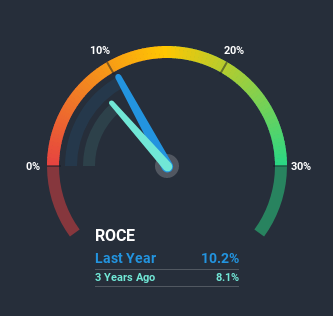Here's What To Make Of Tera Software's (NSE:TERASOFT) Returns On Capital

Did you know there are some financial metrics that can provide clues of a potential multi-bagger? Firstly, we'll want to see a proven return on capital employed (ROCE) that is increasing, and secondly, an expanding base of capital employed. If you see this, it typically means it's a company with a great business model and plenty of profitable reinvestment opportunities. However, after briefly looking over the numbers, we don't think Tera Software (NSE:TERASOFT) has the makings of a multi-bagger going forward, but let's have a look at why that may be.
What is Return On Capital Employed (ROCE)?
For those who don't know, ROCE is a measure of a company's yearly pre-tax profit (its return), relative to the capital employed in the business. To calculate this metric for Tera Software, this is the formula:
Return on Capital Employed = Earnings Before Interest and Tax (EBIT) ÷ (Total Assets - Current Liabilities)
0.10 = ₹114m ÷ (₹2.9b - ₹1.8b) (Based on the trailing twelve months to September 2020).
So, Tera Software has an ROCE of 10%. That's a relatively normal return on capital, and it's around the 12% generated by the IT industry.
Check out our latest analysis for Tera Software

Historical performance is a great place to start when researching a stock so above you can see the gauge for Tera Software's ROCE against it's prior returns. If you want to delve into the historical earnings, revenue and cash flow of Tera Software, check out these free graphs here.
What Can We Tell From Tera Software's ROCE Trend?
In terms of Tera Software's historical ROCE movements, the trend isn't fantastic. To be more specific, ROCE has fallen from 23% over the last five years. Meanwhile, the business is utilizing more capital but this hasn't moved the needle much in terms of sales in the past 12 months, so this could reflect longer term investments. It may take some time before the company starts to see any change in earnings from these investments.
While on the subject, we noticed that the ratio of current liabilities to total assets has risen to 62%, which has impacted the ROCE. If current liabilities hadn't increased as much as they did, the ROCE could actually be even lower. And with current liabilities at these levels, suppliers or short-term creditors are effectively funding a large part of the business, which can introduce some risks.What We Can Learn From Tera Software's ROCE
To conclude, we've found that Tera Software is reinvesting in the business, but returns have been falling. And investors appear hesitant that the trends will pick up because the stock has fallen 55% in the last three years. Therefore based on the analysis done in this article, we don't think Tera Software has the makings of a multi-bagger.
If you want to know some of the risks facing Tera Software we've found 4 warning signs (3 can't be ignored!) that you should be aware of before investing here.
If you want to search for solid companies with great earnings, check out this free list of companies with good balance sheets and impressive returns on equity.
If you’re looking to trade Tera Software, open an account with the lowest-cost* platform trusted by professionals, Interactive Brokers. Their clients from over 200 countries and territories trade stocks, options, futures, forex, bonds and funds worldwide from a single integrated account. Promoted
Valuation is complex, but we're here to simplify it.
Discover if Tera Software might be undervalued or overvalued with our detailed analysis, featuring fair value estimates, potential risks, dividends, insider trades, and its financial condition.
Access Free AnalysisThis article by Simply Wall St is general in nature. It does not constitute a recommendation to buy or sell any stock, and does not take account of your objectives, or your financial situation. We aim to bring you long-term focused analysis driven by fundamental data. Note that our analysis may not factor in the latest price-sensitive company announcements or qualitative material. Simply Wall St has no position in any stocks mentioned.
*Interactive Brokers Rated Lowest Cost Broker by StockBrokers.com Annual Online Review 2020
Have feedback on this article? Concerned about the content? Get in touch with us directly. Alternatively, email editorial-team@simplywallst.com.
About NSEI:TERASOFT
Tera Software
Provides IT and integrated related products and services worldwide.
Solid track record with excellent balance sheet.


